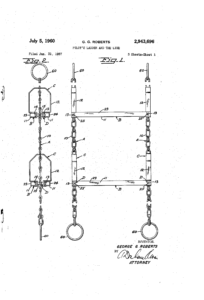 I welcome the whole ‘re-purposing’ movement. It makes fashionable what people all over the world have been doing for thousands of years as a matter of instinct and survival: simple conservation.
I welcome the whole ‘re-purposing’ movement. It makes fashionable what people all over the world have been doing for thousands of years as a matter of instinct and survival: simple conservation.
I would argue that only since the advent of mass-produced goods have we been so willing, and so able, to throw out useful things simply because it’s the easier thing to do. The advertising industry, with their battalion of PhD level psychologists, has conditioned us to feel inferior if we don’t lust after new things, regardless of our actual need. I think most of us have an innate respect for the natural resources that we rely on. I see the current rise of repurposing as a grassroots rejection of the ethics of modern marketing.
That said, check out these shelves fashioned from a boarding ladder that was headed for the landfill.
A single rung as a single shelf approximately 5″ x 19″, suitable for knickknacks.
Or two ladder rungs hung as a double shelf, for even more knacks.
Note: I currently have several of these shelves listed for sale on eBay (click here). They are offered at a fixed price, and at least for the time being will only be available on eBay.
Now, in the unlikely event that you’re not sure what I mean by ‘boarding ladder’, I offer the following. (Skip this part if you already know, but you’ll miss some mildly interesting trivia.)
When an oceangoing ship arrives at its destination, the final few miles into the harbor might be a narrow, shallow, treacherous channel that can change over time. A vessel’s captain often won’t know the proper path to follow, despite modern charts and electronics. For the safety of the vessel, and often mandated by law, a ‘pilot’ is brought out to the ship on a small, fast ‘pilot boat’. The pilot combines exacting local knowledge with the training and experience needed to steer and navigate the ship. The ship’s captain yields control to the pilot for this final approach.
For the pilot, the last few yards of his journey from the shore to the ship is similarly treacherous. The actual transfer from the pilot boat to the ship requires clambering up the outside of the ship on what is called variously a pilot’s ladder, an embarcation ladder, a Jacob’s ladder, or most simply, a boarding ladder. Accidents, injuries and even fatalities are not uncommon during this transfer. Pilots have been plying their trade for centuries, and, to this day, the ladders they use are often nothing more that a simple rope ladder with wooden rungs.
The boarding ladder from which I fashioned these shelves bears the number 2,943,696 stamped into each galvanized steel rung support. Researching that number led to the following discovery:
In 1957 George G. Roberts, an inventor from Redwood City, California filed an application for an invention he titled “PILOTS LADDER AND THE LIKE”.
The application begins: “This invention relates to improvements in ladders with flexible stiles, such as a pilots ladder… which is hung over the side of a ship to enable a pilot to board and leave the ship.” It goes on in considerable length to describe the benefits this improved ladder offers to manufacturers, ship owners. pilots and crews. In 1960, he was awarded patent No. 2,943,696, meaning that these shelve are made from Mr. Roberts improved ladder. Quite a pedigree indeed!
So his invention was successful enough to have made it into production and onto the deck of at least one ship. These shelves show signs of exposure and wear. The wooden rungs are weathered and checked, and the galvanized supports have scrapes and rust acquired in the intervening decades, and occasional bits of paint are visible, rubbed from the hulls of unknown ships in unknown parts of the world. Well traveled, but silent, each self is a small piece of maritime history.
As it turns out, Mr. Roberts was responsible for another item that never quite became a common feature in our daily lives. The patent extract begins:
SAFE EMBODIED IN A BATHTUB
G. G. RQBERTS
Oct. 2l, 1947.
Patent 2,429,487
“This invention relates to an improved combination bath tub and safe and has particular reference to use of a safe in the home where it is conveniently installed in the walled body of the bath tub and is so constructed and positioned in said tub that the exterior appearance of the tub does not indicate that a safe is stored therein.”
I mention the Safe-in-a-Bathtub merely as a curiosity discovered in the course of looking up the patent number stamped into the shelves.











